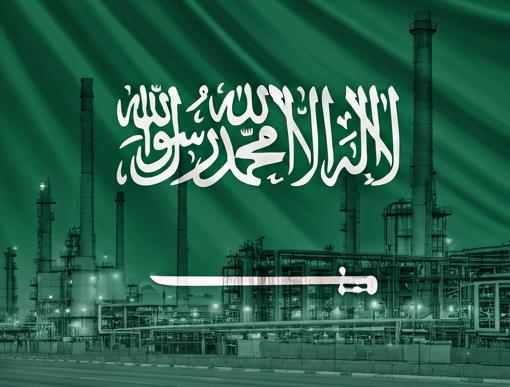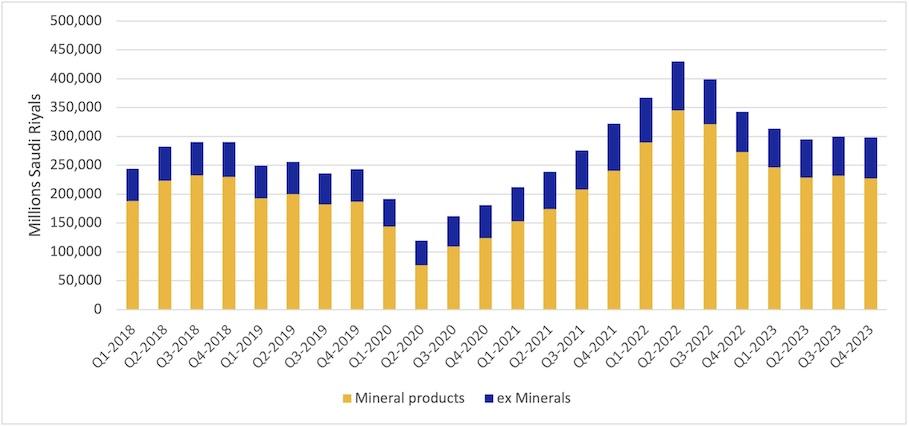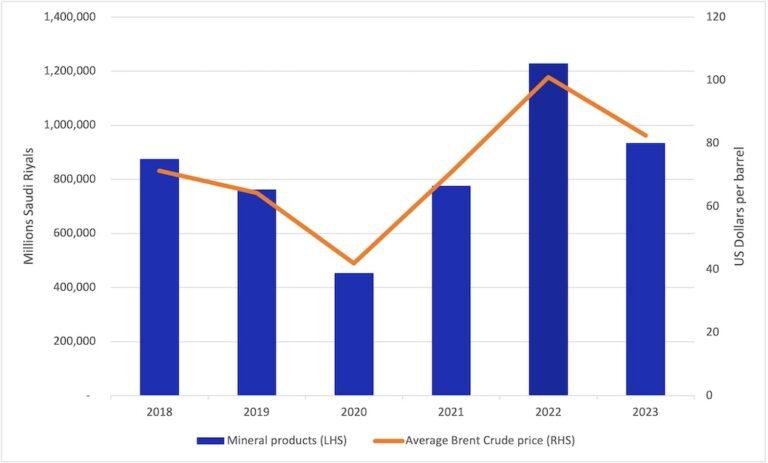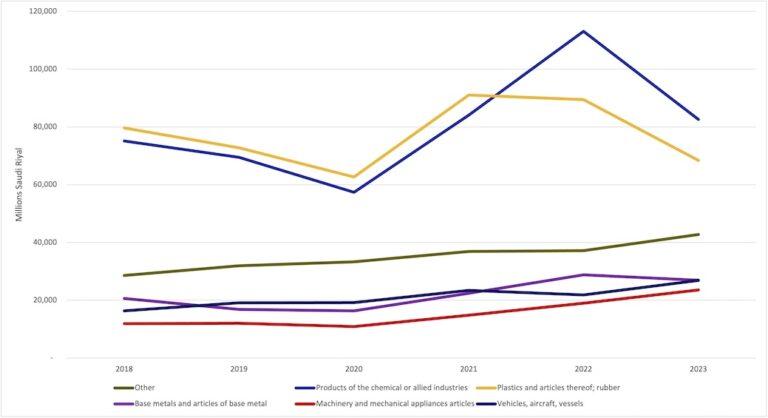
1. Limited Diversification from Oil and Gas
CHART - Exports of Mineral Products (oil and gas) compared to non-mineral products

Saudi Arabia’s oil and gas industry remains the backbone of the country’s economy, accounting for a significant portion of its export revenue. However, the government recognizes the need to diversify its economy away from oil dependence in order to prepare for a future with potentially lower demand for oil. This is due to several factors, including climate change initiatives that are pushing for a transition towards renewable energy sources.
CHART - Saudi Arabia Mineral exports compared to brent crude price

Saudi Arabia’s economic fate is intricately tied to the price of oil, a relationship akin to a double-edged sword. While the vast oil reserves and the ability to act as a swing producer grant them a certain level of influence over the global oil market, their own economic well-being remains tethered to the very fluctuations they can partially manage. This dependence on a finite resource with a future clouded by the specter of climate change initiatives creates a pressing need for diversification.
Despite the ability to adjust oil output and influence global prices, Saudi Arabia’s oil exports remain in a tight dance with those very prices. A rise in global oil prices translates directly into increased revenue for the kingdom, fueling government spending and economic growth. However, this very dependence makes them vulnerable to the flip side of the coin. A slump in global oil prices can have a devastating effect on their national coffers, hindering crucial infrastructure projects, social programs, and overall economic prosperity
CHART - Non-oil exports from Saudi Arabia 2018-2023

Despite ambitious plans for diversification, Saudi Arabia’s non-oil exports haven’t seen significant growth in the past five years. The government is pushing for a more balanced economy, but challenges remain. Recent years haven’t shown a significant uptick in non-oil exports. The main area of expansion lies in hydrocarbon derivatives like plastics and chemicals, which are considered value-added products. However, these sectors are still heavily tied to oil prices. The price fluctuations seen in 2018 (fall), 2020 (COVID-19 impact), and 2023 (rebound and decline) all significantly affected these exports.
Mining Holds Promise, But Remains Extractive
The mining sector offers a promising avenue for diversification, although it’s still an extractive industry. Recent activity in the King Solomon’s gold mines region highlights a shift by the mining ministry. They’ve become more proactive, implementing investment-friendly regulations to create a stronger mining sector. Several new mining developments are underway, including exploration and preparation for production. A joint venture with UK-based KEFI Gold and Copper exemplifies this growing international collaboration.
Manufacturing exports remain limited, with machinery and vehicles constituting the main contributors. Vision 2030, the government’s strategic framework, aims to develop other sectors like tourism and service-oriented businesses.
While efforts are underway, significant progress is needed for a well-diversified economy. Large-scale government stimulus could accelerate the process and create a more balanced export portfolio.
The success of this diversification strategy hinges on developing human capital and fostering innovation within these new sectors. Geopolitical factors and global economic trends will continue to influence Saudi Arabia’s export landscape. Continued investment in infrastructure and logistics will be vital to facilitate trade and attract foreign investment.
Overall, Saudi Arabia’s journey towards a less oil-reliant economy has begun. While challenges are evident, the government’s proactive measures and emerging partnerships offer a glimpse of a more diversified future.
2. Overview of Saudi Arabia Economy
Saudi Arabia, poised for economic transformation under Vision 2030, recognizes the pivotal role of well-developed industrial estates. Spanning 36 operational zones overseen by the Saudi Authority for Industrial Cities and Technology Zones (MODON), these designated areas provide the infrastructure, support, and regulations needed for businesses to thrive across diverse sectors.
Strategic positioning across the country ensures proximity to resources, transportation networks, and key markets. Major clusters in the Eastern Province (Dammam), Western Region (Jeddah), and Central Region (Riyadh) offer investors a range of options suited to their needs.
Infrastructure in Saudi Arabia
Beyond strategic locations, developed infrastructure forms the backbone of these estates. Pre-built facilities, reliable energy and water supply, efficient wastewater treatment, robust communication networks, and convenient transportation links provide a solid foundation for industrial operations. Dedicated customs zones and logistical facilities within many estates further streamline operations and enhance connectivity.
To attract both domestic and international investors, Saudi Arabia boasts investor-friendly regulations. MODON facilitates investment procedures and offers enticing incentives, including tax exemptions, land lease subsidies, and valuable support services. This welcoming environment fosters a dynamic and competitive industrial landscape.
The focus on diversification within Vision 2030 translates to exciting opportunities in non-oil sectors within the estates. Value-added processing and downstream industries in key areas like petrochemicals, mining, and pharmaceuticals hold immense potential for investors seeking lucrative ventures. Specialized clusters within estates, such as the Jubail Industrial City for petrochemicals or the Dammam Second Industrial City for metal industries, offer additional benefits like collaboration and knowledge sharing opportunities.
Future plans for Saudi Arabia
Looking ahead, sustainability occupies a central role in the future of Saudi Arabia’s industrial estates. Eco-industrial parks with sustainable practices, waste management solutions, and renewable energy integration are being prioritized. Additionally, initiatives aimed at attracting and upskilling the workforce are crucial for supporting advanced manufacturing and technology-driven industries.
Furthermore, integration with mega-projects like NEOM and The Red Sea Project presents exciting opportunities for supporting industries and value chains within the estates. Public-private partnerships are expected to play a key role in enhancing infrastructure development and service delivery, ensuring the continued dynamism and competitiveness of these industrial hubs.
Saudi Arabia’s industrial estates offer a fertile ground for investors seeking to capitalize on a growing and diversifying industrial economy. With a focus on advanced technologies, sustainability, and strategic partnerships, these estates are poised to be a key driver of Saudi Arabia’s economic transformation in the years to come.
